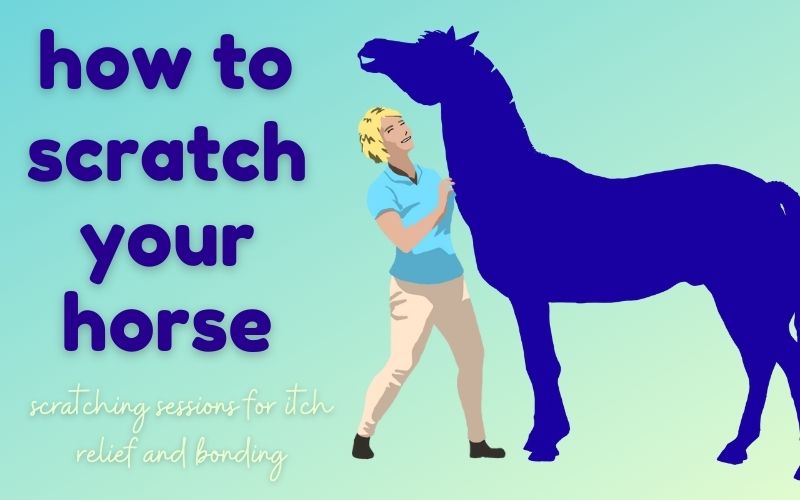
Scratching your horse’s itches is good for your horse’s skin and coat and ideal for bonding. But you might have heard that too much scratching means your horse is rude or teaches your horse bad manners. How to scratch your horse the right way, then? It’s easy! Here’s how to teach your horse to politely and safely enjoy scratches, and give them a fun and soothing enrichment activity in the process.
Why are Horses So Itchy?
Horses love to rub and scratch on trees, posts, and sometimes people. Why all the scratching? They’re itchy! Based on horse behavior, we can guess that the need to scratch feels the same to your horse as it does to you. What’s behind the need to scratch?
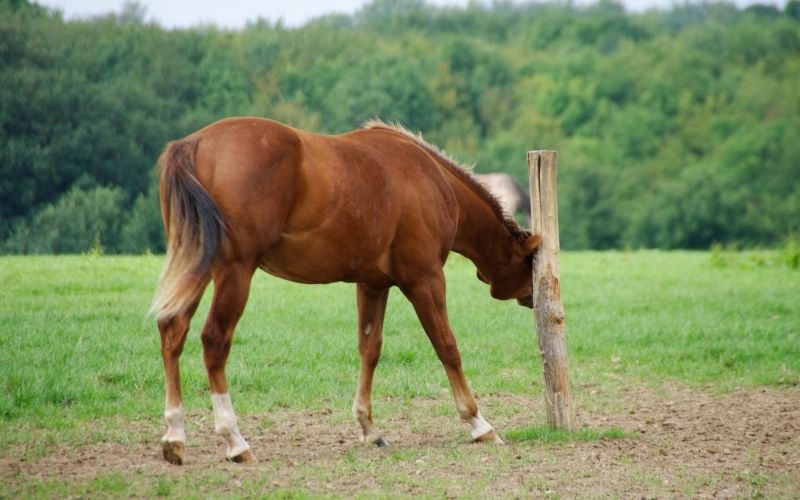
Itchy sensations are a signal that the skin needs attention. Scratching or rubbing is a healthy behavior that can get rid of pests and parasites, clear dead skin or loose hair, and promote better blood flow to the itchy area.
Living outdoors is best for horses and itching is a fact of life for pastured equines. Taking care of itches through rubbing and scratching is healthy. It’s part of your horse’s self maintenance behaviors – things like grooming that they do to take care of their bodies. At certain times of year, especially during shedding season or when insects are active, horses are even itchier than usual.
This means that even if your horse has a scratching post like one of these easy DIY options, they’ll still have areas that itch.
Should You Scratch Your Itchy Horse?
When your horse is itchy, should you scratch them?
Absolutely! There are lots of relationship benefits to helping your horse get itch relief, and it’s good for their skin and coat. But being mindful of how you scratch is important in order for scratching to be fun and safe for both of you.
Some horses enjoy scratches so much that they’ll try to rub themselves all over you, using your clothes as texture for relieving itches. This is why you might have heard that you shouldn’t scratch your horse when they ask or that scratching on a person is disrespectful. Uncontrolled scratching isn’t very safe for you because of how strong horses are – it’s possible to be knocked right over especially if you don’t see it coming! Rubbing head and body all over you isn’t especially effective for your horse either.
At the same time, scratching your horse by hand when they aren’t in the right mood or in the wrong way isn’t ideal. They may try to communicate “no thank you” with unsafe behaviors like nipping or even kicking out.
So how should you scratch your horse?
The best way is to give your horse a scratching session that uses the basics of training and communication to teach your horse how to politely request and enjoy the experience. We’ll cover how to do this below, but first: what are the benefits of scratching sessions?
How to Scratch a Horse: The Benefits
A good scratch session with your equine friend has several benefits.
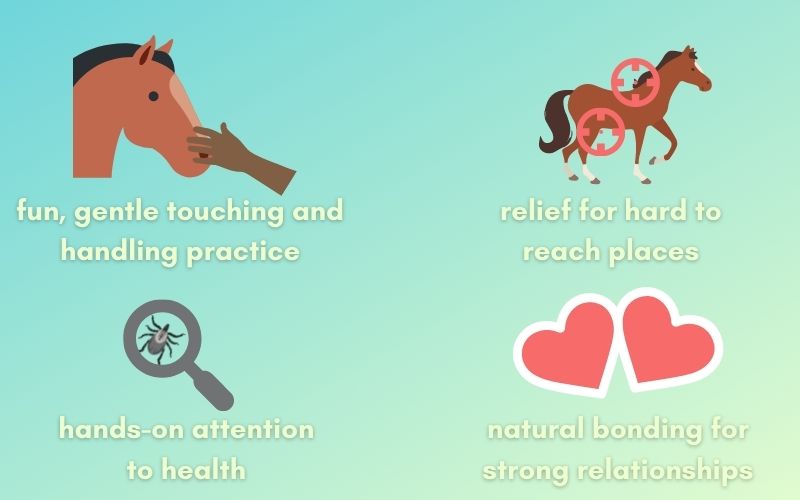
Scratching lets you give your horse targeted itch relief and makes them feel great. You’ll be able to reach places that are hard for them to scratch, like under the neck, tail, and belly. It also lets you observe your horse’s skin and coat carefully. You’ll be able to detect small injuries, bites, or parasites and remove them.
Scratching your horse is also an ideal bonding experience. Mutual grooming is one way that horses strengthen relationships. By scratching your horse when and where they need it, you’ll share a positive experience with your horse that builds a trusting bond.
Lastly, teaching your horse how to enjoy a scratching session improves their manners and behavior. When your horse understands how to behave when they’re itchy, you’ll experience less unwanted “scratch me!” behaviors like rubbing or pushing you. This means you’ll find yourself using less punishment, which also strengthens your horse’s trust in you.
How to Scratch Your Horse: Scratch Session Step by Step
This activity involves a bit of subtle, low-key training. By developing communication between you and your horse, you’ll get an effective and fun scratching experience. They’ll learn to give consent for scratching if they want it, where they’re itchy, and when they’d like you to stop.
Here are the key steps to scratching your horse the right way.
Step One: Work at Liberty
The best way to have a relationship-building, itch relieving scratch session is to work at liberty in the pasture, or with your horse loose in their stall.
The scratching activity is all about communication. Since horses communicate with their body, they need to have space to move around you or walk away. When teaching this activity, work in a safe space but don’t tie up your horse.
Step Two: Create Your Scratching Pose
Next, develop a “scratching pose” that you’ll use to signal to your horse that you’re available to scratch itches.
This part is important because it signals to your horse when it’s okay to move into your space for a scratch. Learning the “want a scratch?” signal keeps your horse from rubbing up against your hands or body at other times.
The easiest scratching post is simply to hold your hands up, fingers slightly curved in the same position you use for scratching.
Step Three: Start Scratching your Horse
Offer a scratching session when your horse isn’t busy doing something else. If they’re eating, let them finish their meal before you begin. Grazing quietly in the pasture is an ideal time to offer scratches.
To start the scratching session, approach your horse and make sure they notice your “scratching pose.” Begin gently scratching in a place you know may be itchy, such as the top of the withers or under their neck.
Scratch for a few seconds, then check your horse’s body language. If they look content or interested, pause your scratching with your hands close to, but not touching, your horse. This is where you’ll begin the back-and-forth communication of a good scratching session.
If your horse enjoyed the scratching, they may lean or step toward you. If they do, immediately continue scratching. This teaches your horse that when the scratching session is offered, they need to indicate that they want it to continue. You’re teaching them how to say yes please!
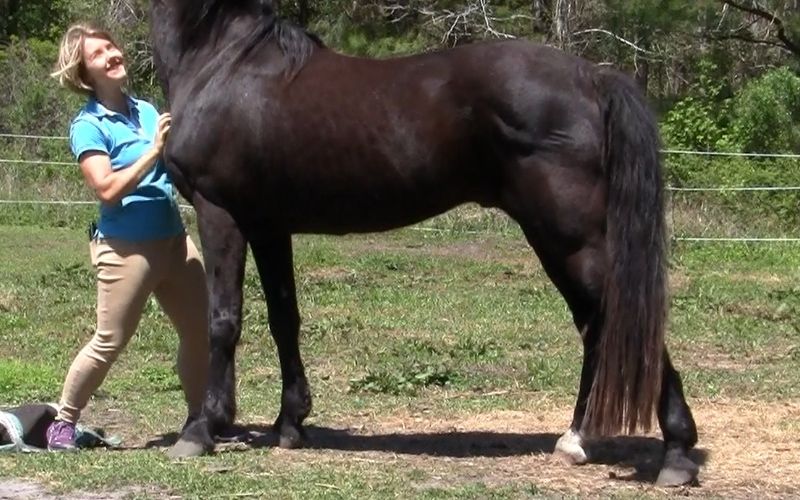
If your horse shifts away or shows other signs of displeasure like pinning their ears, stop scratching and step back. You’re teaching them that you understand their no thank you. Try again later or on a different day, and start scratching in a different spot.
If your horse has a habit of asking for scratches by rubbing against you, redirect their behavior and help them learn by stepping away, holding up your hands in the scratch pose, and then scratching them. The next time you interact, offer the scratch pose before they begin pushing or rubbing.
Step 4: Scratch at the Right Pressure
Every horse has individual preferences. Some have sensitive skin and will lean away if you scratch too hard. Others might be extremely itchy and enjoy hard, vigorous scratching. It’s okay to scratch very hard if your horse leans into you to create more pressure. You might find yourself working up a sweat!
If you’re scratching your horse’s back, neck, or bum, start with the same amount of pressure you’d use to scratch a pretty intense itch on your own back – firm, using your fingernails if you have them (a comb works great too). For more sensitive areas like the face, use gentler pressure. Always respect your horse’s communication and body language.
Step 5: How to Scratch Your Horse Where They’re Itchy
The key to a good scratching session is two-way communication. Once your horse learns your signal for “I’ll scratch if you want,” you can teach them to show you where and how hard they want their scratch session.
The key to this activity is to teach your horse to bring their itchy parts to you. To do this, act like a human scratching post: don’t move around! Stand in one spot and scratch a few inches of skin at a time.
Scratch at a medium pressure. If your horse leans into the scratching, increase the pressure. If they move away slightly, scratch more lightly or rub their coat instead.
This puts your horse in the driver’s seat. With repeated scratching sessions, they’ll figure out that they can walk around you to show you which parts are itchy. When they’re done, they’ll walk away.
The Right Posture to Scratch Your Horse
All horses are strong and can lean into your scratching with a lot of force. A scratching session can be a real workout! To enjoy this activity most, keep your knees bent slightly. If your horse is really itchy and wants a lot of pressure, leaning in with one leg in front of the other works great.
You’ll look pretty silly doing this activity, but that’s ok – that’s part of the fun!
Ending the Scratching Session
Your horse may end the scratching session by walking off to do something else. But you might get tired first! That’s okay – horses end mutual grooming sessions by quietly walking away from each other. If you want to stop scratching, give your horse a gentle rub and lower your hands from the “scratching pose.”
This signals I’m done, no more scratches. If your horse tries to approach or rub you, don’t scratch – if you’re done, leave the pasture or turn your attention away from your horse so that it’s clear that the scratching session has wrapped up.
Staying Safe You Scratch Your Horse
Scratching your itchy horse is safe and fun, but there are a few basic considerations to keep in mind.
First, you’ll need to be respectful and alert to signs of discomfort. If your horse turns or leans away when you’re scratching, stop immediately. Give your horse a chance to decide if they want a different body area scratched, or whether they’re just not in the mood. Don’t keep scratching a horse who pins their ears, shifts away from you, or tries to walk off.
Second, be aware of what your horse is doing and where you’re standing even if your horse loves this activity (and they probably will!) Don’t stand directly in front of or directly behind your horse.
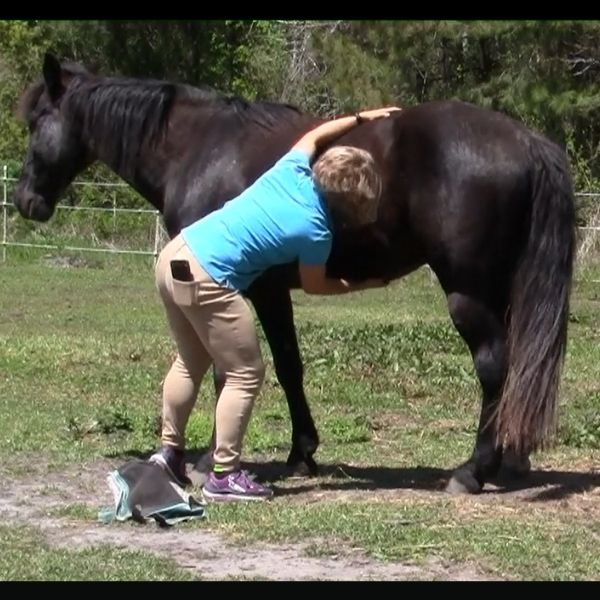
If your horse is too enthusiastic about scratching and throws their head or neck around as they rub into your scratching fingers, pause briefly and take a step back. Continue scratching when they’re standing more calmly. Your horse isn’t being rude or disrespectful; having an itch scratched just feels amazing! But it’s not safe for your horse to rub or push you around. Don’t punish your horse – just let them figure out that the best way to get you to keep scratching is be gentle with you.
Lastly, your horse might show their appreciation by offering to groom you. Unfortunately, horses groom one another using their teeth – so even though your horse means well, this won’t work for your scratching session. If your horse leans over and begins to rub you with their teeth or lips, stop scratching and step back. Remember, there’s no need to yell or smack.
Scratching Sensitive Areas
Thin-skinned parts of your horse’s body can get very itchy, but need special care. Pay special attention to how much pressure you use when scratching sensitive zones like the face, under the belly, or the sheath or teat area.
When scratching the face and poll, be aware of where your horse’s ears and eyes are. Don’t accidentally poke your horse in the eye or base of the ear! Because of the sensitive facial nerves and other structures, you might want to scratch with your knuckles rather than fingertips if you have long nails.
Udders and sheaths do get very itchy and it is okay to scratch them (this helps your horse get used to handling these parts to provide care like cleaning or fly ointment). But this puts you in range of a kick. Don’t scratch these areas until your horse understands how to end a scratching session calmly (with body language or walking off). And always be alert and observant.
If you suspect your horse is abnormally itchy or you notice skin problems, they may need medical care. Look into medical causes for itching and involve a vet if things don’t improve.
How to Scratch a Horse: Bonding and Itch Relief
The scratching activity is a lot of fun and has real benefits for your horse and your relationship. It’s an opportunity to be really hands-on with your horse and discover issues with the skin or coat. Your horse will get the benefits of a personalized scratching session that helps them keep summertime itches under control. And the best part is that it’s a fantastic way to build a trusting relationship with your horse.
Our horses do so much for us every day that it’s nice to give something extra back in return. Your horse will appreciate it!
Related Enrichment
The Scratching Activity is an enrichment activity that encourages self maintenance and grooming.
To give your horse the ability to take care of their own itches, see:
I’ve just found your site and am sucking it up! We do the scratching thing a few times a day 🙂 My pony suffers sweet itch (she is new to me) and I am working hard to keep her comfortable. I feel awful she doesn’t have a scratching post but am worried she might rub herself raw. I’ve bought lots of bits to make a post but don’t know if it’s a good idea.. Do you have any advice please? Also, she is 27 and arthritic so I think I’ll make her a sandpit too… Thanks for all the great insights!
Thanks for the positive feedback, Emily! It’s so cool to hear from people interested in giving more enrichment to their horses. Let’s see if I can get some ideas going for you and your sweet pony.
A scratching post in the paddock and board or panel in the stall is probably a good idea. But I agree, there’s a fine line between the need to relieve the horrible itching, and the risk that she hurts herself scratching so much! Of course (for anyone reading with a similar problem), really pull out all the stops as far as managing the sweet itch from the inside out – medicines, topicals, insect control, etc.
The material you cover the scratching post with can really make a difference. Bare wood can just scrape skin away so I like to use some kind of textured surface. Did you check the texture options on the 5 Scratching Post Ideas yet? For skin health I recommend either the nubbly rubber or the green stadium turf. They’re skin-friendly in my experience: https://enrichingequines.com/diy-scratching-posts-for-horses-5-ideas-to-build-yours/
The other thing will be to anchor that post super well, or put your scratching surface on an existing wall. That way, it never moves or pushes back. This way, she won’t have to scratch “extra” to make up for a shifting scratching post.
I can try to find links and photos for the exact textures if you like – shoot me an email at enrichingequines@gmail.com if you need the specifics!
Good luck with your awesome, itchy pony!